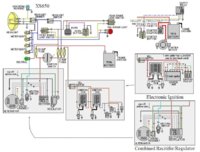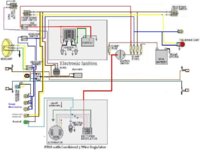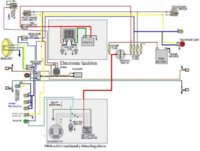The brake light indicater lights up if the brake light blows. The light checker Is wired off the yellow wire that runs from the brake light switches to the brake light. I'm not sure how it does it but the light checker sences the current draw of the brake light and if no current draw as in a blown bulb it grounds the green/white wire and lights the brake light indicater on the dash. Lighting the indicater tells you if the brake light isn't working.
The indicator light gets power on the brown wire that powers most of the bike, things like the horn, turn signals, brake light, and a few other things. The green/white wire from the indicator gets grounded by the light checker to turn it on.
If you are using the stock alternator I might hook in a lighting relay to light that indicater as a charge indicater light.
To hook it up, hook a wire from the yellow wire on the stock alternator to terminal 85 on the relay, ground terminal 86.
The green/white wire from the light checker plug in to terminal 30, terminal 87A to ground.
This way when you turn on the key the light on the dash lights up, indicating the alternator isn't making power. When you start the bike power is sent out on the yellow wire. This power trips the relay. The relay breaks the connnection from 30 to 87A and the indicator on the dash goes out. Works light the idiot light on a car.
I think 5twins or Pamcopete does a simular mod to use the white headlight indicator light as a charge indicator light. I think a red light will be more noticable. We have been trained that red means danger and to always notice red things. Traffic lights, brake lights and lights on cop cars are examples.
You can get the relay at most any parts store, some are only used to turn something on. These have just four terminals. This mod needs one with the fifth terminal, to turn something off. These cost a bit more. The four terminals might cost around $5, the Five terminal may cost around $10.
Not quite as easy to install as a volt meter but look more like stock.
A volt meter or this type of mod will tell you if the alternator quits and lets you get home or a lot closer before the battery goes dead.
If you have done the PMA this mod won't work. Same reason the safety relay won't work, no yellow wire on the PMA mod.
Leo





